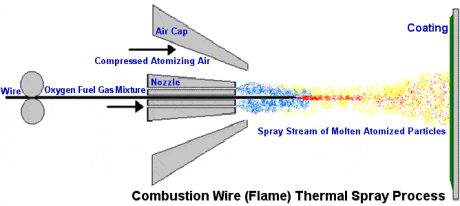Flame Spray Process
The Combustion Wire Thermal Spray Process is the spraying of molten metal onto a surface to provide a coating. Material in wire form is melted in an oxy-acetylene flame and atomized using compressed air to form a fine spray. When the spray contacts the prepared surface of a substrate material, the fine molten droplets rapidly solidify forming the coating. This process is referred to as a cold process(relative to the substrate material being coated) as the substrate temperature can be kept low during processing avoiding damage, metallurgical changes and distortion to the substrate material.
The Combustion Wire Thermal Spray Process is the spraying of molten metal onto a surface to provide a coating. Material in wire form is melted in an oxy-acetylene flame and atomized using compressed air to form a fine spray. When the spray contacts the prepared surface of a substrate material, the fine molten droplets rapidly solidify forming the coating. This process is referred to as a cold process(relative to the substrate material being coated) as the substrate temperature can be kept low during processing avoiding damage, metallurgical changes and distortion to the substrate material.
First invented in 1910 by Schoop in Switzerland, this process has been extensively used in the past and today for machine element work and anti-corrosion coatings.
Advantages of Flame Spray

- Wire form is typically less expensive than powder.
- Deposit efficiency is very high.
- Widely considered the best method of applying pure molybdenum coatings for wear resistance.
- Cold process avoids damage, metallurgical changes, and distortion to substrate material.
- High system portability.
Disadvantages of Flame Spray
- Limited to materials supplied in wire or rod form.
- Not capable of the low oxide, high-density, and high-strength coatings such as those obtained by plasma spray.



